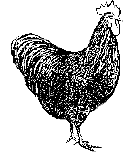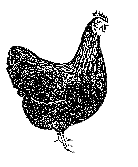Menu
History
of the humble chicken
The Australorp
Putting
the 'feather' in feathery friends
The
baby chick-Nature's miracle child
Chicks
or chocolate-it's an important choice
Ducks!
The other white meat
Sexing
chicks
Using
small incubators
The
Pigeon- more than a park scavenger
Bantams-
mighty midgets of the poultry world
Housing
pigeons
A
Christmas treat for true poultry lovers
Feeding
pigeons
Choices,
choices, choices
Why
DO people breed exhibition birds?
Chook
diseases
"I
never said I was an angel"
Creepy
crawly parasites- those undesirable hitch-hikers!
The
Links |
The Australorp - A dinki di Aussie!
The Australorp originated as the product of
judicious breeding by Australian poultrymen who saw the
potential of the William Cook Orpington breed and sought to improve the utility features.
The Orpington had been taken down a solely fancy path,
becoming big, loose "feather dusters" and losing their original purpose along
the way. The original Cook Orpington was crossed with Australian Langshan and Minorca and
over time became what we now know as the Australorp. It was sent back to Britain where it
caused a sensation and became known as the Australian Utility Orpington, later shortened
to Austral Orpington then to Australorp. It was called the "boomerang breed" as
the British believed it to be simply a Cook Orpington. To this day in the British Book
of Poultry Standards, they claim it erroneously as a British breed, which is simply
not true.
 Poultrymen in each Australian state believed their
birds to be the "true" Australorp and the resultant bickering and state
loyalties prevented a Standard from being drawn up in Australia. The Poultry Club of Great
Britain drew up a Standard which was published. This spurred Edwin Hadlington, the
Government Poultry Expert in New South Wales to call a meeting of all state
representatives to draw up a true Standard for the breed. In 1947, this meeting was held
and birds were taken from Jim O'Malley's yards in Queanbeyan (Jim is still alive today and
still loves poultry) and photographed. During the meeting, alterations were made to the
photographs according to delegate consultation and agreement and finally a Standard and
illustrations were approved. This Standard was sent to England where it was immediately
adopted almost word perfectly as the official Australorp Standard. Poultrymen in each Australian state believed their
birds to be the "true" Australorp and the resultant bickering and state
loyalties prevented a Standard from being drawn up in Australia. The Poultry Club of Great
Britain drew up a Standard which was published. This spurred Edwin Hadlington, the
Government Poultry Expert in New South Wales to call a meeting of all state
representatives to draw up a true Standard for the breed. In 1947, this meeting was held
and birds were taken from Jim O'Malley's yards in Queanbeyan (Jim is still alive today and
still loves poultry) and photographed. During the meeting, alterations were made to the
photographs according to delegate consultation and agreement and finally a Standard and
illustrations were approved. This Standard was sent to England where it was immediately
adopted almost word perfectly as the official Australorp Standard.
Along with the White Leghorn, the Australorp is recognised
as one of the most important breeds in the history of the poultry industry, being used
extensively in the creation of modern laying hybrids. Unfortunately, as years passed by,
the true type of the Australorp was changed dramatically with birds of loose feather and
poor type becoming popular. However there is only one true Australorp and that is a bird
of curves, looking longer than tall, tight in feather, open and bright in face, with a
bold black eye and the glossiest beetle green plumage.
 Thankfully in Australia, this correct type of bird
is returning in large numbers on the showbench and as a result is again one of the
strongest breeds found at shows. To breed correct type Australorps, one must start with
the very best foundation stock as can be found. Turn the birds front-on and avoid any
which are narrow and slab sided. Choose birds with tight plumage, showing thigh and with
good width between the legs. The eyes MUST be jet black with the face very finely
textured, bright red and open, the eye seeming as a large black spot dead centre of the
face. The birds must feel heavy and be free of deformity, though Australorps seem to be
relatively free of the faults most commonly found in similar heavy breeds. Choose birds
which are active and alert, the Australorp is a lively forager. Ideally the feet will have
white soles, but do not reject any bird which shows some black here as they are good
breeders. Look for sound dark beaks, white in the beak is a sign of weak colour and birds
bred from white beaked stock will lose the beetle green sheen. NEVER breed from birds
showing purple in the plumage as this is a bad fault in Australorps. Australorps come in
large and bantam sizes. Thankfully in Australia, this correct type of bird
is returning in large numbers on the showbench and as a result is again one of the
strongest breeds found at shows. To breed correct type Australorps, one must start with
the very best foundation stock as can be found. Turn the birds front-on and avoid any
which are narrow and slab sided. Choose birds with tight plumage, showing thigh and with
good width between the legs. The eyes MUST be jet black with the face very finely
textured, bright red and open, the eye seeming as a large black spot dead centre of the
face. The birds must feel heavy and be free of deformity, though Australorps seem to be
relatively free of the faults most commonly found in similar heavy breeds. Choose birds
which are active and alert, the Australorp is a lively forager. Ideally the feet will have
white soles, but do not reject any bird which shows some black here as they are good
breeders. Look for sound dark beaks, white in the beak is a sign of weak colour and birds
bred from white beaked stock will lose the beetle green sheen. NEVER breed from birds
showing purple in the plumage as this is a bad fault in Australorps. Australorps come in
large and bantam sizes.
In Australia, black is the only colour seen, but there have
been the odd white sport appear from time to time. Overseas, blues are also found but to
show a blue Australorp in Australia would be somewhat akin to blasphemy! Anyone
contemplating getting chickens for the first time would be hard pressed to find a better
breed to start with than Australorps, but then again.... maybe I'm just biased because I
am a dinki di Aussie too! |
 Poultrymen in each Australian state believed their
birds to be the "true" Australorp and the resultant bickering and state
loyalties prevented a Standard from being drawn up in Australia. The Poultry Club of Great
Britain drew up a Standard which was published. This spurred Edwin Hadlington, the
Government Poultry Expert in New South Wales to call a meeting of all state
representatives to draw up a true Standard for the breed. In 1947, this meeting was held
and birds were taken from Jim O'Malley's yards in Queanbeyan (Jim is still alive today and
still loves poultry) and photographed. During the meeting, alterations were made to the
photographs according to delegate consultation and agreement and finally a Standard and
illustrations were approved. This Standard was sent to England where it was immediately
adopted almost word perfectly as the official Australorp Standard.
Poultrymen in each Australian state believed their
birds to be the "true" Australorp and the resultant bickering and state
loyalties prevented a Standard from being drawn up in Australia. The Poultry Club of Great
Britain drew up a Standard which was published. This spurred Edwin Hadlington, the
Government Poultry Expert in New South Wales to call a meeting of all state
representatives to draw up a true Standard for the breed. In 1947, this meeting was held
and birds were taken from Jim O'Malley's yards in Queanbeyan (Jim is still alive today and
still loves poultry) and photographed. During the meeting, alterations were made to the
photographs according to delegate consultation and agreement and finally a Standard and
illustrations were approved. This Standard was sent to England where it was immediately
adopted almost word perfectly as the official Australorp Standard. Thankfully in Australia, this correct type of bird
is returning in large numbers on the showbench and as a result is again one of the
strongest breeds found at shows. To breed correct type Australorps, one must start with
the very best foundation stock as can be found. Turn the birds front-on and avoid any
which are narrow and slab sided. Choose birds with tight plumage, showing thigh and with
good width between the legs. The eyes MUST be jet black with the face very finely
textured, bright red and open, the eye seeming as a large black spot dead centre of the
face. The birds must feel heavy and be free of deformity, though Australorps seem to be
relatively free of the faults most commonly found in similar heavy breeds. Choose birds
which are active and alert, the Australorp is a lively forager. Ideally the feet will have
white soles, but do not reject any bird which shows some black here as they are good
breeders. Look for sound dark beaks, white in the beak is a sign of weak colour and birds
bred from white beaked stock will lose the beetle green sheen. NEVER breed from birds
showing purple in the plumage as this is a bad fault in Australorps. Australorps come in
large and bantam sizes.
Thankfully in Australia, this correct type of bird
is returning in large numbers on the showbench and as a result is again one of the
strongest breeds found at shows. To breed correct type Australorps, one must start with
the very best foundation stock as can be found. Turn the birds front-on and avoid any
which are narrow and slab sided. Choose birds with tight plumage, showing thigh and with
good width between the legs. The eyes MUST be jet black with the face very finely
textured, bright red and open, the eye seeming as a large black spot dead centre of the
face. The birds must feel heavy and be free of deformity, though Australorps seem to be
relatively free of the faults most commonly found in similar heavy breeds. Choose birds
which are active and alert, the Australorp is a lively forager. Ideally the feet will have
white soles, but do not reject any bird which shows some black here as they are good
breeders. Look for sound dark beaks, white in the beak is a sign of weak colour and birds
bred from white beaked stock will lose the beetle green sheen. NEVER breed from birds
showing purple in the plumage as this is a bad fault in Australorps. Australorps come in
large and bantam sizes.